What is Potassium?
Potassium is one of the most essential minerals in your body. After all, it literally keeps your heart beating at a steady rate!
Potassium plays a role in many other vital bodily functions too. In fact, your brain, kidneys, muscles, and (yes!) your bones, all rely on this mineral…
So in this post, we’ll take a look at potassium’s health benefits. Then, we’ll go over the top 35 potassium-rich foods. (It may surprise you there’s more to this list than just fruits and vegetables!) And as a bonus, you’ll find a printable shopping list near the bottom of the page.
But first, for a quick introduction to potassium, watch the video below:
9 Health Benefits of Potassium
Potassium’s main functions include sending nerve signals, regulating muscle contractions, and managing fluid balance. And of course, these functions apply to systems throughout your body! So getting plenty of potassium supports several aspects of health.
Here, we’ll go over the top nine health benefits of potassium:
1. Supports Nervous System
Potassium is vital for the health of your nervous system, which is made up of nerve cells throughout your body. Now, nerve cells are responsible for relaying messages between your brain and other parts of your body. For example, nerve impulses help regulate muscle contractions like your heartbeat.
So how is potassium involved? Well, nerve impulses rely on potassium. They’re generated by potassium ions moving in and out of cells. This process creates the electrical potential that allows a nerve impulse to fire.
That’s why low potassium concentration in blood (hypokalemia) can impair nervous system functions and cause everything from an abnormal heart rhythm to muscle paralysis. Less severe potassium deficiency can produce milder symptoms like fatigue and muscle weakness.
As you can see, your nerve signals need potassium to function at a basic level and regulate all sorts of bodily functions! So this first benefit ties in with many that follow…
2. Maintains Fluid Balance
Potassium is a key electrolyte that helps maintain fluid balance in your body. As you may know, your body is composed of approximately 60% water! And the regulation of that water is essential for optimal health.
Specifically, you need a balance of intracellular and extracellular fluid to support bodily functions. These fluid types are just what they sound like! Intracellular fluid (ICF) refers to fluid inside your cells and extracellular fluid (ECF) refers to fluid outside your cells.
This is where potassium comes into play. Potassium can mostly be found in your ICF and at smaller concentrations in your ECF. Sodium is potassium’s counterpart — it can be found in high concentrations in your ECF and low concentrations in your ICF.
Now, there’s a fine balance of potassium between your ICF and ECF called potassium homeostasis. Potassium homeostasis is maintained by the sodium-potassium pump. This pump is found in your cell membranes, and it moves potassium ions into cells and sodium ions out of the cells. (Note this is the same process we discussed above that creates electrical potential!)
But in terms of your ICF and ECF, the sodium-potassium pump is key for maintaining balance. It ensures you have an equal amount of electrolytes (potassium and sodium), and thus fluid, inside and outside your cells at all times!
3. Regulates Muscle Contractions
As we’ve seen, potassium is crucial for nerve impulses to fire. And of course, muscles contract in response to nerve impulses. So you need potassium to move all your muscles!
More specifically, the contraction and relaxation cycle of your muscles depends on potassium — and that includes your heart (more on this in a moment!). Again, the sodium-potassium pump plays a key role in this process.
When your muscles contract, it may cause a loss of potassium. The sodium-potassium pump works to rectify this imbalance. In other words, it keeps your fluid and electrolyte levels balanced during and after physical exertion. In this way, the sodium-potassium pump supports physical performance and recovery.
4. Supports Heart Rate
Your heart is widely considered the hardest working muscle in your body. On average, it pumps an impressive 2,500 gallons of blood a day. And over a person’s lifespan, it can beat over 3 billion times!
Now, we’ve covered how potassium is essential for muscle contractions. And your heart is no exception. So to maintain a healthy heart rate, your body needs potassium. This relationship becomes clear when you look at the effects of high or low potassium levels on your heart.
Too much potassium (hyperkalemia) can lead to an abnormal heart rhythm. In scientific terms, this is called a cardiac arrhythmia. On the other end of the spectrum, too little potassium can also cause cardiac arrhythmia! As you can see, it’s all about balance.
If you’ve been experiencing issues with an irregular heartbeat, speak with your healthcare provider to see if a potassium deficiency could be playing a role.
5. Reduces Risk of Stroke
Because of potassium’s role in the regulation of the nervous system, heart function, and fluid balance, a diet high in potassium can help reduce the risk of stroke.
In fact, in a systematic review of 22 randomized controlled trials, researchers found that higher potassium intake was associated with a 24% lower risk of stroke. It’s worth noting that the evidence for this association was considered “moderate quality” because of factors like variability in study populations. But more recent studies do support this finding.
In another meta-analysis of 16 cohort studies (a type of longitudinal study that looks at a particular group of people who share a characteristic), researchers found an inverse relationship between potassium intake and stroke risk. In other words, higher potassium intake lowered the risk of stroke. Specifically, consuming 3,400 mg of potassium a day was associated with the lowest risk of stroke.
Now, these studies show a strong association between potassium intake and stroke reduction. But they don’t show a “cause effect” relationship. So more research is needed to confirm this relationship. Nonetheless, when you consider potassium’s essential functions, it makes sense that this mineral would have stroke protective benefits!
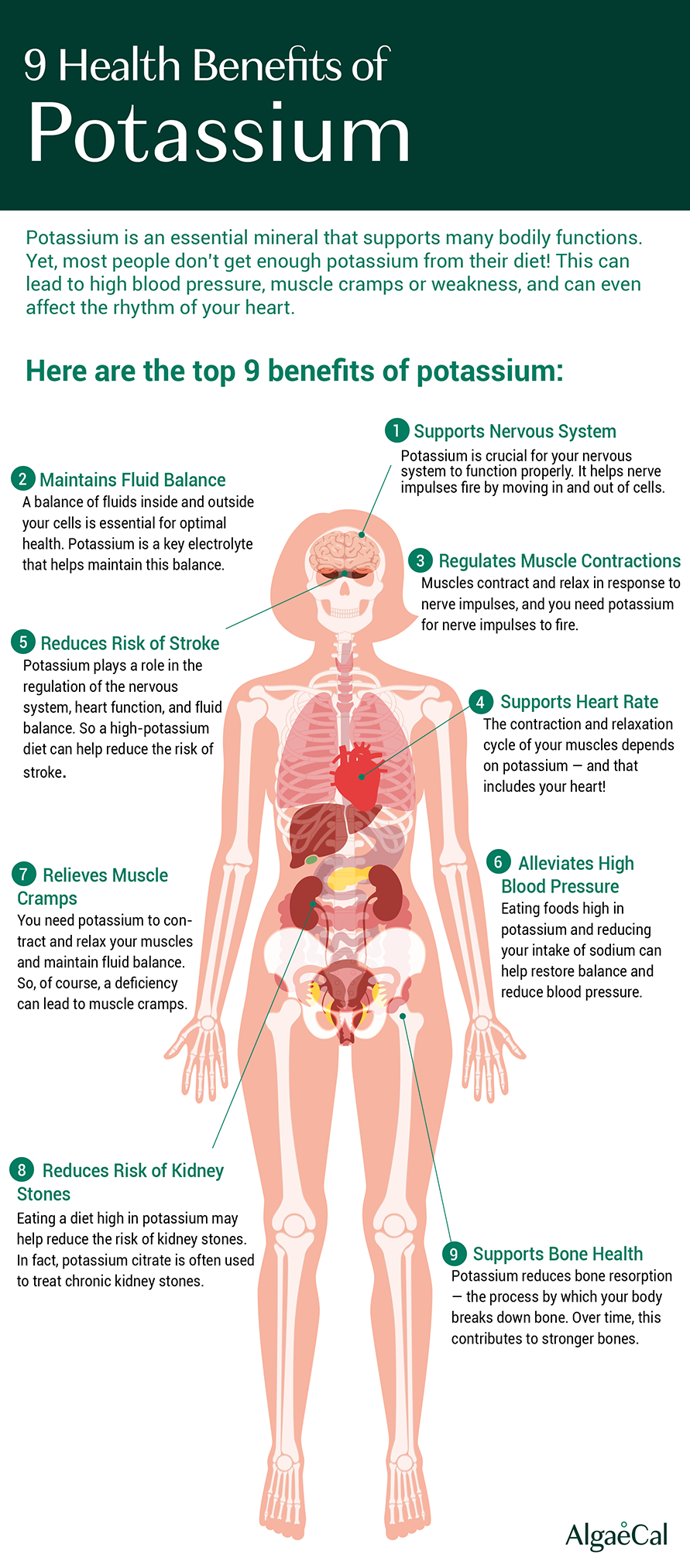
6. Alleviates High Blood Pressure
Your blood pressure and sodium intake are closely related. Consuming too much sodium (salt) has been shown to increase your blood pressure. Sodium consumption is also linked to conditions like hypertension and cardiovascular issues.
Now, this makes perfect sense when you consider the fact that sodium-potassium balance is key for regulating your heart rate!
Unfortunately, the standard American diet (SAD) often provides too much sodium and not enough potassium. That’s because processed foods contain high levels of sodium, while foods like fruits and vegetables are rich in potassium. Because of this imbalance, the Centers for Disease Control and Prevention reports nearly half of adults in the U.S. have high blood pressure!
The good news is, by eating potassium-rich foods and reducing your sodium intake, you can restore balance and reduce your blood pressure. (Don’t worry, we’ll go over a big list of potassium-rich foods next!)
7. Relieves Muscle Cramps
As discussed above, you need potassium to maintain fluid balance and contract and relax your muscles. These functions explain why a deficiency in potassium can lead to muscle cramps. It also explains why potassium can help alleviate menstrual cramps.
Thankfully, eating plenty of potassium-rich foods can help prevent muscle cramps in the first place. Upping your potassium intake can also help reduce muscle weakness and fatigue — which gives you more energy to move throughout the day!
For those who engage in a lot of physical activity, maximizing potassium intake is especially important. That means always having potassium-rich foods on hand for snacks and meals. But as you’ll see in the list to come, there are a wide variety of potassium-rich foods to choose from!
8. Reduces Risk of Kidney Stones
Potassium has been shown to reduce the risk of kidney stones in several human studies. In fact, potassium citrate (potassium bound with citric acid) is often used to treat chronic kidney stones.
This is because potassium citrate attaches to calcium in urine and prevents the formation of mineral crystals that can develop into calcium stones. It also prevents urine from becoming too acidic, which reduces your risk of uric acid stones or cystine stones forming. (Uric acid stones and cystine stones are two less common types of kidney stones that can occur as a result of fluid loss or due to certain genetic factors.)
But the good news is, research suggests high potassium intake can reduce your risk of kidney stones. Yet another reason to incorporate the potassium-rich foods we’ll go over below in your diet!
9. Supports Bone Health
In addition to supporting overall health, potassium plays an important role in your bone health! In fact, research shows that potassium reduces bone resorption — the process by which your body breaks down bone. Over time, this effect contributes to stronger bones.
Potassium may also be important for calcium balance. Studies show that potassium intake is associated with less excretion of calcium through urine. In other words, it helps you retain more calcium, which supports your bone health. Evidence for this effect is mixed, but a recent double-blind randomized controlled trial suggests why this might be…
In this study, participants were assigned to receive either 60 mmol/d of potassium citrate, 90 mmol/d of potassium citrate, or a placebo. At the end of six months, researchers found that 90 mmol/d of potassium citrate (which is about 1600 mg) was required to significantly improve calcium balance. So the mixed results from previous studies may be a result of insufficient potassium doses.
Finally, if we look at clinical trials of potassium’s effect on bone mineral density (BMD), its benefits become clear. In one trial, supplementing with potassium citrate helped protect against BMD loss at the spine, femoral neck, and hip. In another more recent study that included a placebo group, potassium, alongside calcium and vitamin D, helped improve BMD and bone microarchitecture (bone quality!). The results of this last study are promising and support the importance of potassium as part of a multi-nutrient approach to bone health.
To discover an easy way to get potassium, calcium, vitamin D, and everything else you need for strong, healthy bones, click here.
So we’ve seen how important potassium is for everything from your heart to your bones! But before we get into the top potassium-rich foods, let’s have a look at exactly how much you need…
How Much Potassium Do You Need?
The National Academies of Sciences, Engineering, and Medicine (NASEM) recently updated the Dietary Reference Intakes (DRIs) for potassium.
Like in the past, they found insufficient evidence to establish an Estimated Average Requirement (EAR). But they did set new Adequate Intake (AI) levels for all ages. Now, it’s worth noting the AI reflects the minimum amount of potassium healthy individuals need — not how much you need for optimal health.
The NASEM committee recommends that women aged 19 and older get at least 2,600 mg of potassium a day and men aged 19 and older get at least 3,400 mg a day.
For reference, here’s a table from the National Institutes of Health that shows the potassium AIs for all age ranges:
| Age | Male | Female |
| Birth to 6 months | 400 mg | 400 mg |
| 7–12 months | 860 mg | 860 mg |
| 1–3 years | 2,000 mg | 2,000 mg |
| 4–8 years | 2,300 mg | 2,300 mg |
| 9–13 years | 2,500 mg | 2,300 mg |
| 14–18 years | 3,000 mg | 2,300 mg |
| 19–50 years | 3,400 mg | 2,600 mg |
| 51+ years | 3,400 mg | 2,600 mg |
Now, the new AIs are lower than the recommendations from 2005. Specifically, for adults the AI used to be 4,700 mg of potassium a day. The committee explains these reductions, in part, because the new AIs don’t take into account chronic disease risk reduction (CDRR). Instead, CDRR was considered separately. But in the end, the committee found insufficient evidence to set a recommendation for a potassium CDDR.
All this to say, it’s best to think of these new recommendations as the bare minimum to aim for. Depending on factors like how much physical activity you engage in, your current health, and your ethnicity, you may very well need more!
And you don’t need to worry too much about going over the AI for potassium. The committee found insufficient evidence to set a tolerable upper intake level for potassium. But they did share that short-term potassium supplementation of around 2,500 mg a day “appears to be safe for generally healthy individuals”. (That’s on top of potassium obtained through diet!)
A Note on Sodium, Potassium, and Magnesium Balance
It’s also important to note that balancing your sodium and potassium intake is extremely important. As you saw earlier, high sodium intake combined with low potassium intake can lead to high blood pressure. So along with the recommended potassium intake, you should aim to consume no more than 1,500 mg of sodium a day.
For the best health outcome, a good rule of thumb is to try and maintain a 2:1 ratio of potassium to sodium.
Magnesium also affects your sodium and potassium balance. That’s because potassium needs magnesium to help it across the cell membrane. So without adequate magnesium, your cells can’t take up as much potassium. In fact, magnesium deficiency is frequently associated with hypokalemia (low potassium levels).
So you’ll want to make sure you’re getting an optimal amount of magnesium too! (If you’re getting the recommended 1,200 mg of calcium a day, then you need 600 mg of magnesium. Visit our magnesium-rich foods page for more information on ideal intake, and for a list of the best dietary sources.)
So how can you make sure you’re getting adequate potassium? The first step is to eat plenty of potassium-rich foods! That’s where the following list comes into play…
Top 35 Potassium-Rich Foods List
Here are the top 35 foods, in order of potassium content:
Bonus: You’ll find a free, printable version of this potassium-rich foods list a little further down the page.
| Food Item | Serving size | Approx. | Potassium in Mg |
| Apricots, dried | 100 grams | ⅓ cups | 1,162 |
| Avocado | 1 medium | 975 | |
| Potato, baked with skin | 1 medium | 941 | |
| Raisins | 100 grams | ⅔ cups | 744 |
| Prunes | 100 grams | 10 prunes | 732 |
| Medjool dates | 100 grams | 4 dates | 696 |
| Pomegranate | 1 medium | 666 | |
| Peanuts, dry-roasted | 100 grams | ⅔ cup | 634 |
| Coconut water | 1 cup | 600 | |
| Spinach, raw | 100 grams | 3 cups | 558 |
| Sweet potato, baked with skin | 1 medium | 542 | |
| Soybeans, cooked | 100 grams | ½ cup | 512 |
| Lima beans, boiled | 100 grams | ½ cup | 508 |
| Salmon, wild Atlantic, raw | 100 grams | ¼ fillet | 490 |
| Acorn squash, cooked | 100 grams | ½ cup | 437 |
| Kidney beans, canned, cooked | 100 grams | ½ cup | 433 |
| Tomato, raw | 1 large | 431 | |
| Banana | 1 medium | 422 | |
| Sardines, canned | 100 grams | 1 can | 397 |
| Chicken breast, grilled | 100 grams | ½ breast | 391 |
| Brussels sprouts, raw | 100 grams | 1 cup | 389 |
| Mustard greens | 100 grams | 1 cup | 384 |
| Yogurt, plain, whole milk | 1 cup | 380 | |
| Lentils, cooked | 100 grams | ½ cup | 369 |
| Milk, 1% | 1 cup | 366 | |
| Kale | 100 grams | 4 cup | 348 |
| Beets, raw | 100 grams | 1 large beet | 325 |
| Lean ground beef | 100 grams | 1 extra large patty | 318 |
| Mushrooms, white | 100 grams | 1 cup | 318 |
| Broccoli, raw | 100 grams | 1 cup | 316 |
| Nectarine or peach | 1 medium | 285 | |
| Cantaloupe | 100 grams | 1 large wedge | 267 |
| Orange | 1 medium | 237 | |
| Honeydew melon | 100 grams | 1 small wedge | 228 |
| Kiwifruit | 1 medium | 215 |
Apricots, dried — 1,162 mg / 100 grams
You might think dried apricots aren’t as healthy as fresh ones. But even though some heat-sensitive vitamins like vitamin C are affected during the drying process, other nutrients actually become more concentrated! And yes, potassium is one of them.
Dried apricots offer more potassium per bite than fresh apricots and contain a whopping 1,162 mg of potassium per 100 grams! Plus, their prolonged shelf life makes them a convenient snack to keep in your pantry. Just remember to enjoy them in moderation, as these fruits are high in natural sugar too.
Avocado — 975 mg / 1 medium
Don’t let the fact that avocados are high in fat scare you off. Avocados contain healthy, monounsaturated fats, which provide heart-protective benefits. What’s more, they’re rich in bone-healthy vitamin C, magnesium, and of course, potassium. Specifically, one medium avocado provides 975 mg of potassium.
So look to avocados for a filling, healthy meal or snack! Some ideas include: Using avocados in place of mayo or other unhealthy spreads on sandwiches and wraps; upgrading your salads; or blending some into your next smoothie to get a delicious, creamy texture and an extra kick of nutrition.
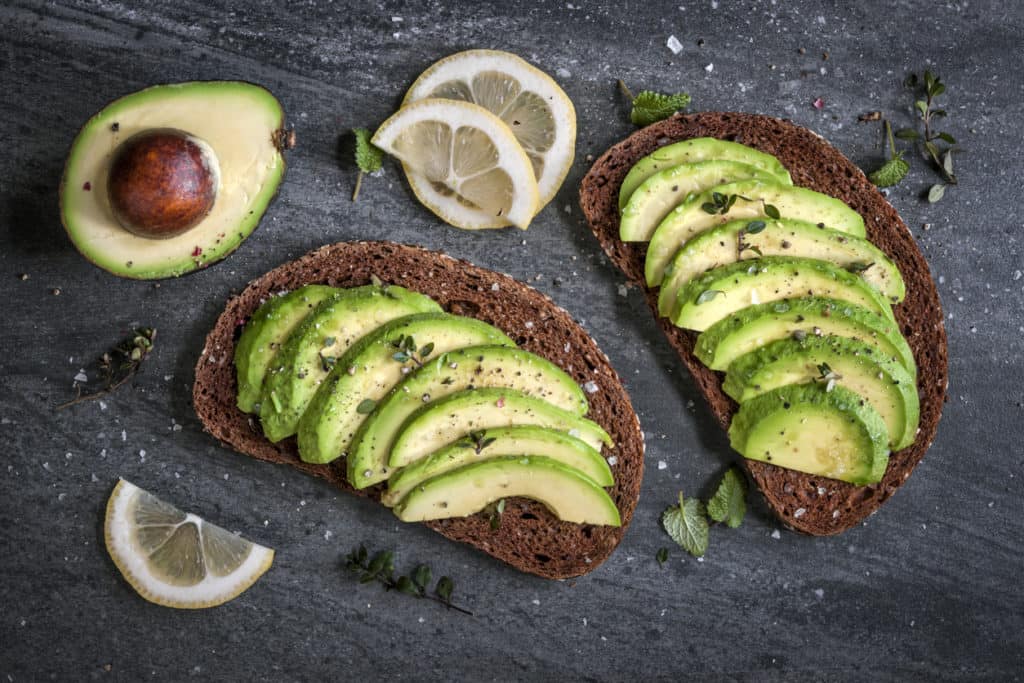
Potato, baked with skin — 941 mg / 1 medium potato
Did you know there are over 100 different edible varieties of potatoes? And each variety has many health benefits! Potatoes, mostly thanks to their peels, are rich in magnesium, potassium, copper, and vitamin C — all of which support healthy bones. In fact, a medium baked potato with skin offers 941 mg of potassium.
So to enjoy the health benefits of potatoes, keep the peel when cooking and choose a preparation method other than frying. For example, try making baked potato skin nachos loaded with other healthy vegetables like black beans, spinach, and bell peppers. For a kick of calcium, add a dollop of cold yogurt and a sprinkle of cheese. Enjoy!
Raisins — 744 mg / 100 grams
Raisins are one of those foods you either love or hate. If you fall into the “love” category, you’ll be pleased to know raisins contain moderate amounts of bone-healthy nutrients like calcium and magnesium. But raisins really shine when it comes to their potassium content…
For every 100 grams of raisins (that’s about ⅔ cups), you get 744 mg of potassium. So keep a stash of these in your pantry, and throw in a handful next time you’re making some healthy muffins or homemade granola bars. Just remember, like dried apricots, raisins contain natural sugar, so don’t overdo it either. It’s also worth noting the Environmental Working Group reports 99% of non-organic raisins contain at least two pesticides. So if you can, opt for organic!
Prunes — 732 mg / 100 grams
Did you know that studies show prunes may have bone-protective properties? It’s not surprising when you consider these fruits contain several key nutrients for bone health, including boron, magnesium, and potassium. Per 100 grams of prunes, you get a generous 732 mg of potassium!
Like with dried apricots, the dehydration process boosts the nutrient content in prunes. So add a couple of these tasty fruits to your daily diet and your bones will thank you. But if you don’t care for prunes, and you’re concerned about your bone density, not to worry. There are 24 other foods on this list after all!
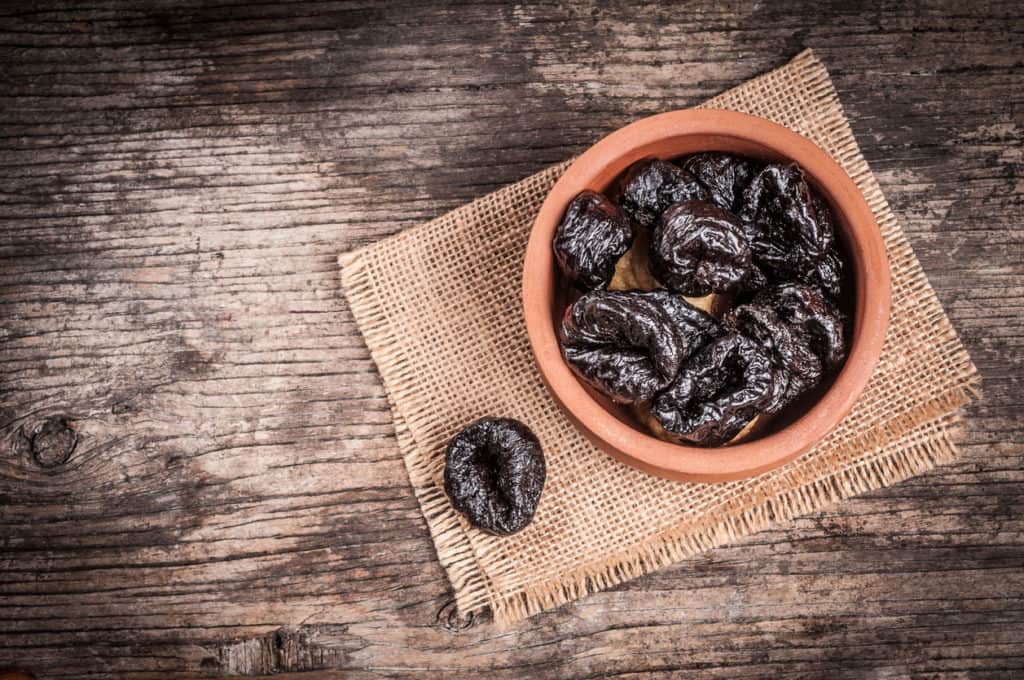
Medjool dates — 696 mg / 100 grams
There are over 30 varieties of dates in the world, but the most common in the U.S. are Medjool dates.These dates have a caramel-like consistency and flavor, so make an excellent replacement for candy and sugar in recipes. That said, dates contain a lot of natural sugar, so it’s best to consume them in moderation.
But having a few dates on occasion won’t hurt. In fact, it may help! Dates are rich sources of several bone-healthy nutrients, including calcium, magnesium, and potassium. To be exact, four dates, which equals about 100 grams, provides an impressive 696 mg of potassium!
Pomegranate — 666 mg / 1 medium
Pomegranates are a beautiful, bright red fruit that look almost like apples. But pomegranates are considered a berry! The exterior of the pomegranate is actually inedible, but once you crack it open, it contains hundreds of juicy, sweet seeds. These seeds make a great snack, salad garnish, or addition to a smoothie.
But pomegranate seeds aren’t just delicious! They’re also rich in bone-healthy nutrients, including vitamin C, magnesium, and potassium. Just one medium-sized pomegranate provides 666 mg of potassium.
So look out for this berry in the produce aisle. If you can’t find fresh pomegranates, you can also buy ready-to-eat seeds in the refrigerated area of many grocery stores. Note that pomegranate season generally runs from October to February.
Peanuts, dry-roasted — 634 mg / 100 grams
Peanuts are a nutrition powerhouse. They offer 634 mg of potassium per 100 grams (about a ⅔ cup). They’re also high in magnesium, manganese, and protein — all of which support strong, healthy bones.
So if you can have peanuts in your household, try adding them to trail mix as a snack, sprinkle on top of salads, or even make your own peanut sauce for dipping. Just make sure you check the label on canned peanuts to avoid additives. And if you eat peanut butter, opt for a natural variety to avoid added sugar!
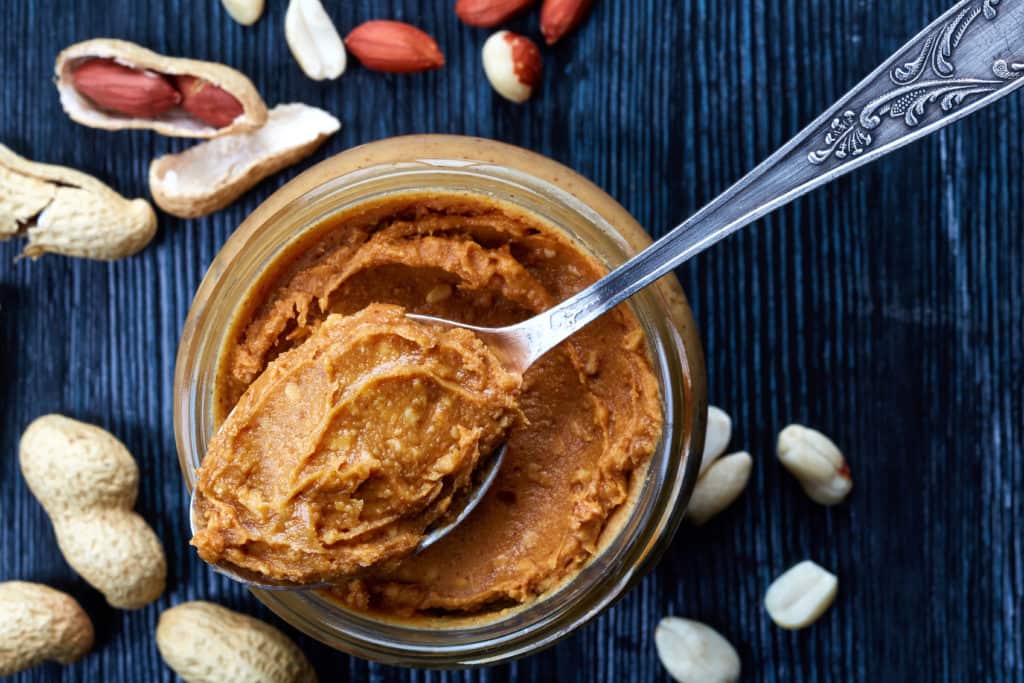
Coconut water — 600 mg / 1 cup
Coconut water has become a popular health beverage in recent years! You can find it in most grocery stores these days. And many health and fitness websites recommend coconut water as a natural, post-workout beverage.
The main reason for this recommendation is that coconut water is rich in potassium. In fact, one cup provides 600 mg of potassium. And if you recall, potassium helps regulate fluid retention, muscle cramps, and blood pressure — all especially important benefits for athletes. It also provides bone-healthy calcium, magnesium, and vitamin C. So go ahead and try a glass after a workout, or add this delicious beverage to your morning routine!
Spinach — 558 mg / 100 grams
Spinach is a green, leafy vegetable you definitely want to include in your diet. It’s delicious, versatile, and an excellent source of many key nutrients for bone health. Spinach is especially rich in calcium, magnesium, vitamin C, and potassium.
For every 100 grams of spinach, you get an impressive 558 mg of potassium. Now, 100 grams of spinach is about three cups, which might seem like a lot. But if you cook your spinach, it shrinks down drastically, meaning you pack in a lot of nutrients with every bite. So go ahead and add a bag of spinach to your next soup, pasta sauce, or curry. Or make yourself a big spinach salad for lunch with eggs or chicken for extra protein. Yum!
Sweet potato, baked with skin — 542 mg / 1 medium
Did you know sweet potatoes are the root of a beautiful lavender flower? Yes, this nutritious vegetable is a beautiful plant to grow. With their deep orange color, sweet potatoes are also attractive additions to any meal.
Plus, they have a lot to offer in terms of nutrition. Both the flesh and peel of sweet potatoes contain many key bone-healthy nutrients, like vitamin C, magnesium, and potassium. Specifically, one medium sweet potato with its skin intact provides 542 mg of potassium.
So keep the peel to get the most out of your sweet potatoes! There are endless ways to cook them up too. Try making your own healthy sweet potato fries, bake them whole, cut them into small cubes and saute in a pan, or boil them to make mash.
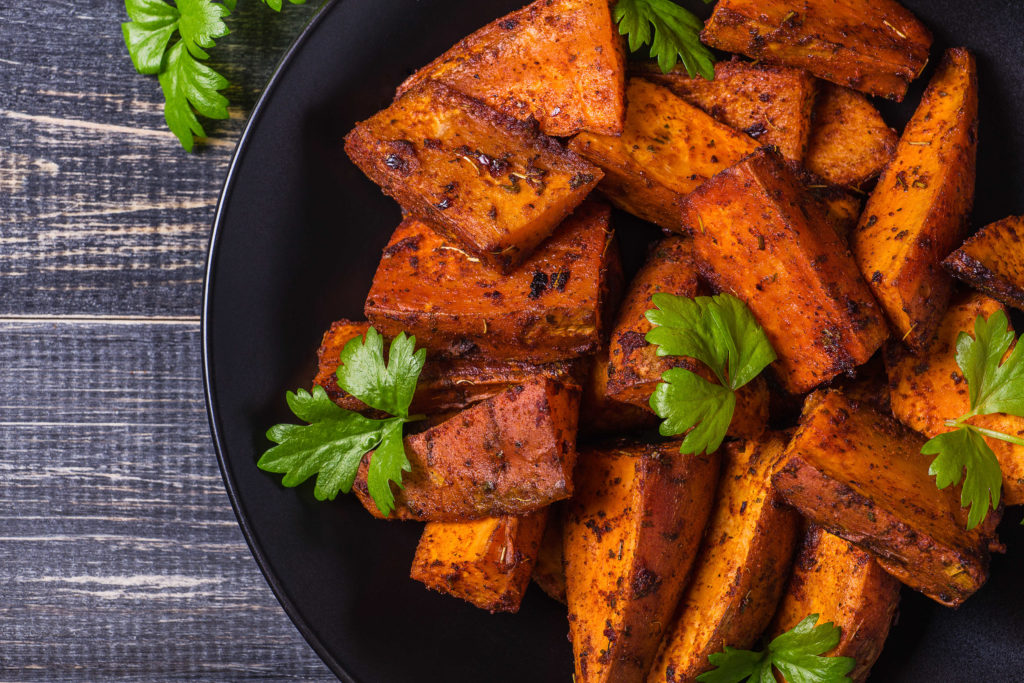
Soybeans, cooked — 512 mg / 100 grams
Soybeans are well-loved for their versatility and nutrition profile. Notably, soybeans are very rich in protein. In fact, they’re considered a complete source of protein because they contain all the essential amino acids — which is very rare for non-animal proteins! And of course, protein is key for strong, healthy bones.
Soybeans also offer a good amount of calcium, magnesium, and of course, potassium! For every 100 grams of soybeans, you get 512 mg of potassium. So don’t be deterred by those who doubt the health benefits of soybeans. Much of the debate about whether soy is healthy or not isn’t based in sound science. To discover what research really says about soybeans, visit our comprehensive post “Is Soy Good or Bad For You?”
Lima beans, boiled — 508 mg / 100 grams
Lima beans are also known as “butter beans” because of their buttery flavor. They’re a very convenient legume, as you can buy them canned, year-round at most grocery stores. And like most legumes, they’re a rich source of nutrients.
Lima beans are high in bone-healthy protein, magnesium, and yes, potassium! If you boil your lima beans, you’ll get about 508 mg of potassium per 100 grams. (That’s about a half cup.)
Unfortunately, these beans have a bit of a reputation for not being that tasty. But if you prepare them properly, they can be delicious! Try blending them up to make your own hummus, add them to a vegetable soup for a nice texture, or even blend a few in your morning smoothie for an extra kick of nutrition.
Salmon, wild Atlantic, raw — 490 mg / 100 grams
Salmon fights bone-damaging inflammation in two ways! One, it’s rich in inflammation-fighting omega 3 fatty acids. And two, it contains the powerful antioxidant astaxanthin.
What’s more, salmon is a good source of high-quality protein, and other nutrients you need for strong bones like selenium and magnesium. As for potassium, salmon offers 490 mg per 100 grams. (That’s just a quarter fillet!)
If you’re wondering how to prepare salmon, you have lots of options! This fish is equally delicious pan-seared, baked, roasted, or even made into burgers. (Note, you’ll find a salmon burger recipe a little further down!)
Acorn squash, cooked — 437 mg / 100 grams
Acorn squash is a type of winter squash, and like its name suggests, it’s mostly available in winter. This type of squash is known for having a long shelf life, so it’s a convenient fruit to have on hand. (Yes, technically squash is a fruit, not a vegetable!)
Both the flesh and the seeds of acorn squash are rich in nutrients that support your bone health. That includes vitamin C, magnesium, and potassium. In terms of potassium, every 100 grams of acorn squash provides 437 mg.
If you don’t use the seeds when you’re cooking acorn squash, be sure to set them aside. Like pumpkin seeds, they make a delicious, healthy snack, if you season and roast them in the oven!
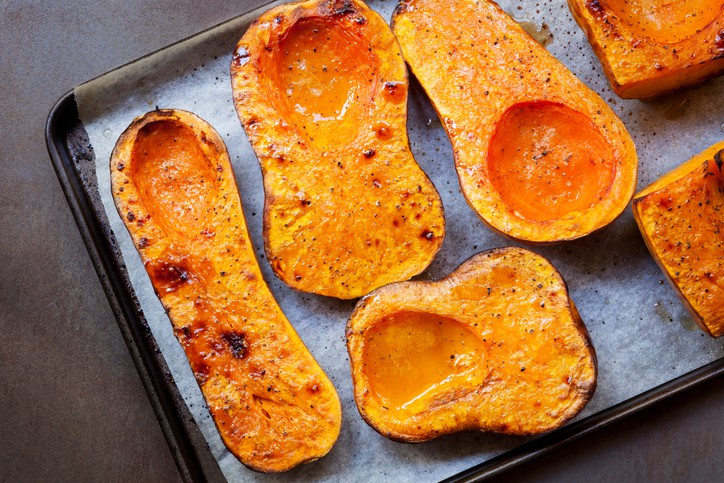
Kidney beans, canned, cooked — 433 mg / 100 grams
True to their name, kidney beans are shaped like kidneys, and they’re usually a beautiful, dark red color. These tasty beans are often used in chilis, soups, or baked on their own.
In terms of nutrition, kidney beans have a lot to offer. In addition to 433 mg of potassium per 100 grams, they’re a good source of protein and magnesium — all of which support healthy bones. These legumes are also well-known for helping control blood sugar. So be sure to pick up a few cans next time you’re at the grocery store. You should be able to find them year-round!
Tomato, raw — 431 mg / 1 large
Regardless of whether you call it a fruit or vegetable, tomatoes are a highly nutritious food! Just one large tomato (about 3 inches in diameter) provides 431 mg of potassium. That same tomato offers 24.9 mg of vitamin C — an important vitamin for your bones and immune system.
Despite packing a lot of nutritional value, tomatoes are low calorie. They contain just 32.8 calories per one large tomato to be exact! So you can be liberal with your tomato consumption.
Go ahead and make yourself a tomato bocconcini salad for lunch, add a couple slices to your next sandwich or wrap, or treat yourself to some homemade spaghetti sauce! (Note that for sauces, homemade is always best to avoid added sugar.)
Banana — 422 mg / 1 medium
Bananas are famous for being rich sources of potassium. And yes, one medium banana offers a generous 422 mg of potassium. That’s in addition to other bone-healthy nutrients like magnesium and vitamin C. But as you can see from this list, they’re actually not the most potassium-rich food out there!
Nonetheless, bananas are one of the most accessible food sources of potassium. They’re inexpensive, readily available at grocery stores, corner stores, and even coffee shops, and they make a quick, easy snack. Try adding a banana to your morning oatmeal, chop one up and mix with yogurt, or smear with peanut butter for an energy boost!

Sardines, canned — 397 mg / 100 grams
You may have heard that sardines are excellent for your bones because they’re a rich source of calcium. And it’s true! Just 100 grams of sardines (about one can) delivers 382 mg of calcium. But these little fish are even richer sources of potassium — that same 100 grams provides 397 mg of potassium.
What’s more, sardines are high in protein and inflammation-fighting omega 3 fatty acids. So there are many reasons to include sardines as part of your bone-healthy diet. There are many ways to eat sardines too. Some ideas include making your own sardine pate, adding them to pasta sauce, or even, swap out anchovies for sardines in your next caesar salad.
Chicken breast, grilled — 391 mg / 100 grams
Chicken breasts are low fat and high protein, so they’re an excellent option if you’re watching your weight. But chicken breasts have a lot more to offer than protein! They’re also rich in minerals that support bone health like selenium, magnesium, and potassium.
In fact, eat just half a chicken breast (about 100 grams), and you’ll consume 391 mg of potassium. That means, if you have a whole chicken breast for dinner, you’ll get a whopping 782 mg of potassium! Not bad for one meal.
There are endless ways to enjoy chicken too. Simply pan-seared with some butter, stuffed with spinach and cheese, grilled and tossed in a salad, chopped up and added to a soup, casserole, or pasta, or marinated and slow-cooked in a crock pot. No matter how you cook your chicken, even the pickiest eaters will be pleased!
Brussels sprouts, raw — 389 mg / 100 grams
Brussels sprouts aren’t just for the holidays! These tasty cruciferous vegetables can generally be found year-round, and they make an excellent side dish year-round too. They’re delicious raw or cooked, but note that cooked Brussels sprouts are slightly less rich in nutrients.
For every 100 grams of Brussels sprouts, you get 389 mg of potassium. That’s in addition to other bone-healthy nutrients like calcium, magnesium, and manganese. But Brussels sprouts really shine when it comes to vitamin C. In fact, 100 grams offer 85 mg of vitamin C — that’s more than the RDA for women 19+ of 75 mg.
So next time you’re trying to think of a good side dish, think Brussels sprouts. Try thinly slicing them like cabbage and making a slaw, roasting them with a little olive oil and salt and pepper, or sauteing with garlic butter. Whichever option you choose, your bones will thank you!
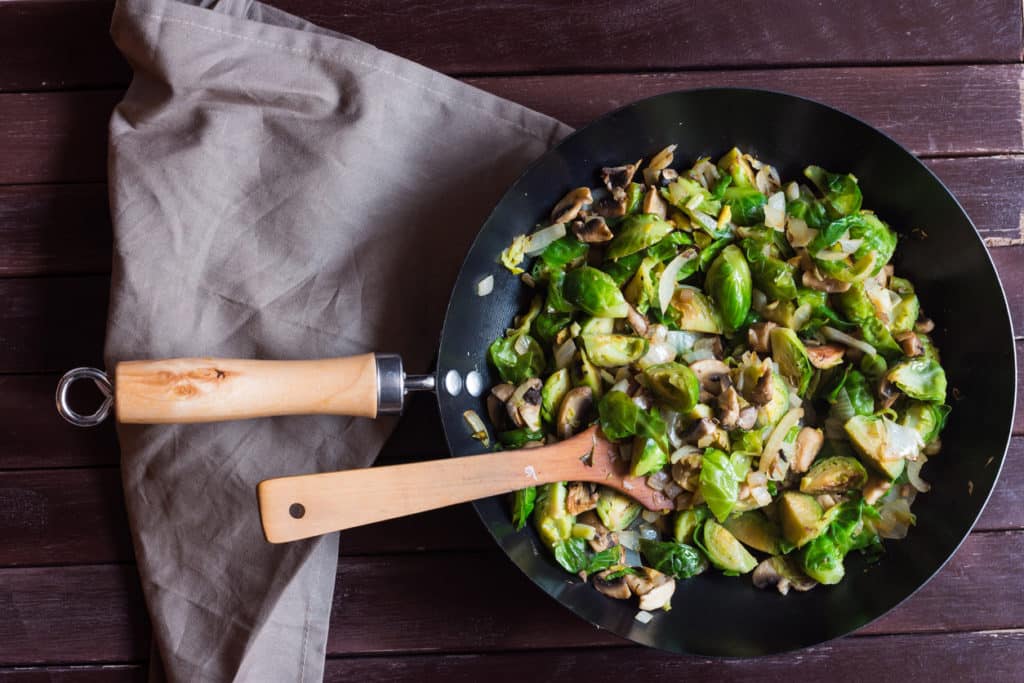
Mustard greens — 384 mg / 100 grams
Mustard greens are similar to collard greens, but they’re even richer in potassium! Just 100 grams (about two cups) of mustard greens deliver 384 mg of potassium. These greens are also a rich source of calcium and vitamin C. So overall, mustard greens are an excellent choice for your bones.
If you’ve never had mustard greens before, you’re in for a treat! This green, leafy vegetable has a lively, peppery flavor that tastes almost like spicy mustard. But don’t worry, the flavor isn’t overpowering, and these greens are delicious sauteed, added to stew, or stirred into sauce.
Yogurt, plain — 380 mg / 1 cup
Yogurt is a good source of bone-healthy protein. (If you opt for Greek yogurt, you’ll get even more protein!) Of course, yogurt is a dairy product, so it also provides calcium. And for every cup of yogurt, you get 380 mg of potassium.
What’s more, some varieties of yogurt contain live bacteria, or probiotics, that may benefit digestion. Just be sure to check the label to see whether your yogurt contains probiotics — many pasteurized varieties don’t!
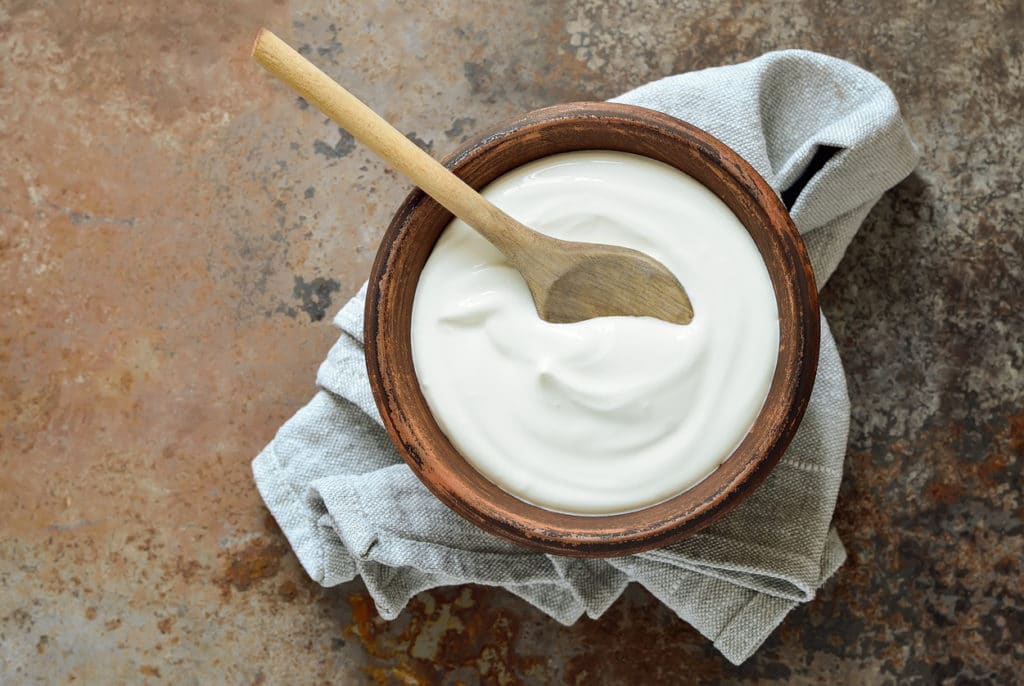
Lentils, cooked — 369 mg / 100 grams
Traditionally, lentils are a staple in Asian and North African cuisines. But in recent years, they’ve also become popular in North America. In fact, Canada is the greatest producer of lentils, followed closely by India.
Their growing popularity is largely thanks to their nutritional value. Lentils offer a wide range of nutrients, many of which are key for your bone health. In addition to being a good source of vegetarian protein, lentils offer generous amounts of magnesium, manganese, zinc, and potassium. For every 100 grams (about a half cup!), you get 369 mg of potassium.
Lentils are easy to cook too. Just give them a good rinse, cover with water and a pinch of salt, bring to a boil, and let simmer uncovered for 20 minutes or less depending on your preference. Then, add them to spaghetti sauce, salad, or soup for an extra nutritious meal!
Milk, 1% — 366 mg / 1 cup
Milk is actually richer in potassium than calcium! That said, it’s an excellent source of both these bone-healthy minerals. Just one cup of milk offers 366 mg of potassium and 305 mg of calcium. So a simple glass of milk goes a long way to fulfilling your daily needs.
Kale — 348 mg / 100 grams
Kale is one of the most nutrient dense vegetables you can put on your plate. It provides generous amounts of vitamin C, calcium, magnesium, and of course, potassium. For every 100 grams of kale, you get 348 mg of potassium. So this vegetable definitely deserves a spot in your bone healthy diet!
But kale has a strong, earthy taste, and the leaves are quite tough. So knowing how to prepare it properly makes a big difference. If you’re making a kale salad, try massaging in the dressing. This will soften the leaves and create a gentler flavor. You can also throw kale into soups, sauces, and even smoothies if you’re feeling adventurous!
Beets, raw — 325 mg / 100 grams
Beets are low calorie, but highly nutritious and flavorful. In fact, 100 grams of beets, which equals about one large beet, contains only 43 calories. Yet that same 100 gram serving offers a moderate amount of calcium, magnesium, and vitamin C. And beets really deliver on potassium! Per 100 grams, you get 325 mg of potassium.
There are many ways to eat beets too. They’re delicious roasted, steamed, pickled, or even juiced. If you buy them fresh, you can also eat the green leafy tops of the beetroot. Beet leaves are rich in nutrients too, and you can cook them just like spinach.
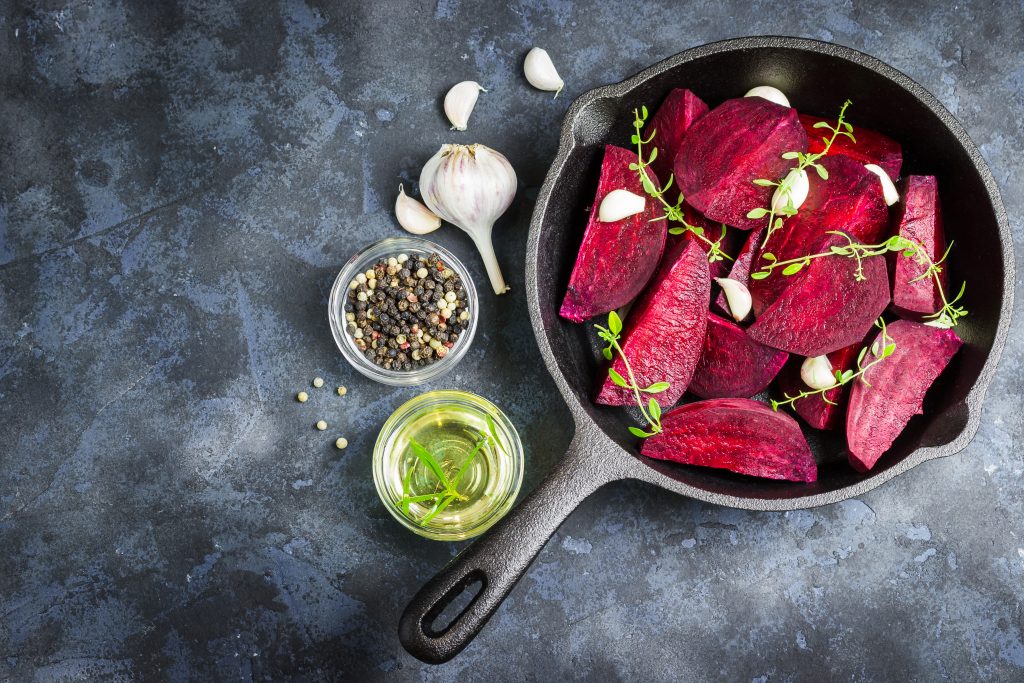
Lean ground beef — 318 mg / 100 grams
Many of the potassium-rich foods on this list are fruits and vegetables, but don’t overlook meat! Just like chicken and salmon, beef provides a generous amount of potassium. For every 100 grams of lean ground beef, you get about 318 mg of potassium. (For reference, one small burger patty is on average 77 grams.)
Different types of meat like steak, tenderloin, and ribs provide comparable amounts of potassium too. Notably, beef is also an excellent source of zinc, which supports your bone health and immune system. And of course, the protein content of beef far surpasses that of vegetables.
So there are many reasons to include beef as part of a bone-healthy diet. Try it in chili with kidney beans for extra potassium, make a shepherd’s pie with potassium-rich potatoes, or go with a classic like meatloaf for your next big meal!
Mushrooms, white — 318 mg / 100 grams
Mushrooms aren’t particularly rich in many nutrients, but there are a few exceptions! And potassium is one of them. Potassium content will vary depending on mushroom type, but your average white mushrooms provide about 318 mg of potassium per 100 grams.
White mushrooms also contain some selenium and copper — two additional minerals that support bone health. And since mushrooms are low calorie and fat-free, they make a great addition to any meal.
There are so many ways to prepare mushrooms. But some easy ones include making cream of mushroom soup, adding chopped mushrooms to sauce, or simply sauteing in a pan!
Broccoli, raw — 316 mg / 100 grams
Broccoli is the original “superfood”! Broccoli was a household staple long before kale or avocados took off. And to this day, it remains a popular vegetable thanks to its distinctive taste and remarkable nutritional profile.
Broccoli provides many nutrients that your bones crave, including calcium, magnesium, and vitamin C. For every 100 grams, which equals just a little less than a cup of chopped broccoli, you get 316 mg of potassium.
So by all means, if you love broccoli, keep eating it! If you’re not a big fan, it may be worth experimenting with creative ways to prepare it. Who knows, a hearty broccoli cheese soup might just win you over.

Nectarine or peach — 285 mg / 1 medium
Nectarines and peaches are closely related! They’re both “stone fruits”, which means they contain a stone in their middle. They also contain the same amount of potassium: 285 mg per one medium nectarine or peach.
These fruits are also decent sources of bone-healthy vitamin C. But beyond their nutritional value, nectarines and peaches are just downright delicious. They make a perfect afternoon snack, breakfast paired with some yogurt, or even sweet addition to a summer salad.
Cantaloupe — 267 mg / 100 grams
Cantaloupe is so refreshing and makes a wonderful, healthy substitute for a calorie-laden dessert. It’s also delicious chopped up and added to some water for a natural sweetener. Or in a fruit salad for breakfast or a snack!
And you don’t have to feel guilty about eating this fruit. In addition to being low calorie, it’s rich in nutrients that support your bone health. That includes vitamin C, and of course, potassium. Per 100 grams of cantaloupe (about 1 large wedge), you get 267 mg of potassium. So if you ate a whole medium-sized cantaloupe over the course of the week, you’d get 1470 mg of potassium!
Orange — 237 mg / 1 medium
Oranges are known for being high in vitamin C, but they have so much more to offer nutritionally.These sweet citrus fruits are also a good source of calcium and potassium. Specifically, one medium orange offers 237 mg of potassium.
Enjoy fresh oranges as a natural, sweet treat, or try something new by adding them to a cooked, savory dish. If you drink orange juice, choose freshly-squeezed if possible. (Processed orange juices often contain a lot of added sugar!)
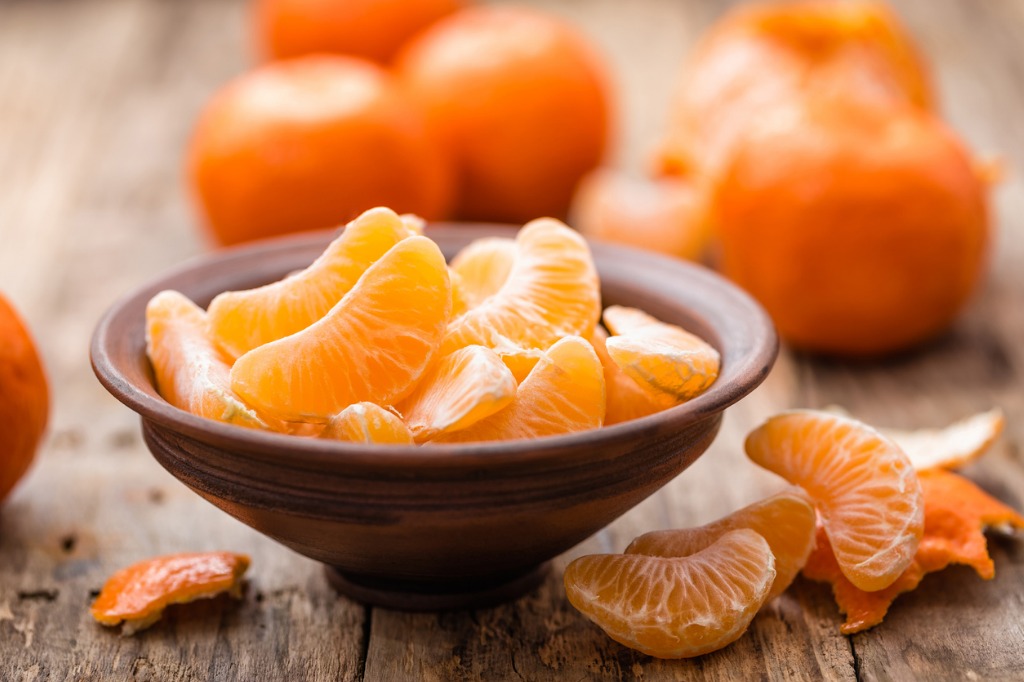
Honeydew melon — 228 mg / 100 grams
Honeydew melons are as sweet as their name implies! Yet, they’re also low calorie and contain bone-healthy nutrients. In addition to 228 mg of potassium per 100 grams, honeydew melon provides 18 mg of vitamin C. Not bad, if you consider 100 grams equals about one small wedge of melon.
So honeydew makes an excellent substitute for dessert or a healthy, refreshing snack on a hot summer day! If you’re feeling adventurous, you could also make a melon salsa or wrap slices of melon in prosciutto for a delicious appetizer.
Kiwifruit — 215 mg / 1 medium
Kiwifruit (usually just called kiwi!) is a rich source of many nutrients that support strong, healthy bones. This small fruit contains a surprising amount of calcium and potassium. Per one kiwi, you’ll get about 215 mg of potassium. But kiwis really deliver on vitamin C, with that same fruit offering 64 mg — that’s almost the RDA of 75 mg for women!
When choosing your kiwi, gently apply pressure to the skin. Avoid kiwis that are too soft and cave in when you apply pressure. But if the fruit is slightly tender, you have a winner! Try adding sliced kiwi to a fruit salad for a pop of flavor, treat yourself to one as an afternoon snack, or add a whole kiwi with its nutrient-rich skin intact to your morning smoothie.
The Top Potassium-Rich Foods Shopping List [Free PDF]
As you can see, many foods are rich in potassium! So you have a lot of options for boosting your potassium intake. But don’t worry, there’s no need to memorize all 35 of these foods before heading to the grocery store…
That’s where our potassium-rich foods shopping list comes in handy!
The following PDF lists the top potassium-rich foods by category, including protein, dairy, fruit, and vegetables. It also covers a few simple tips to keep in mind when shopping for bone-healthy ingredients. Simply, click the red “Print” button below to download your free copy.
[ac_banner name=”potassium_foods_pdf”]
Recipes with Potassium-Rich Foods
You can eat most, if not all, of the potassium-rich foods listed above on their own. But half the fun of incorporating new foods in your diet is getting to try new recipes!
So to help inspire you, here are a few delicious, potassium-rich recipes from the AlgaeCal Kitchen:
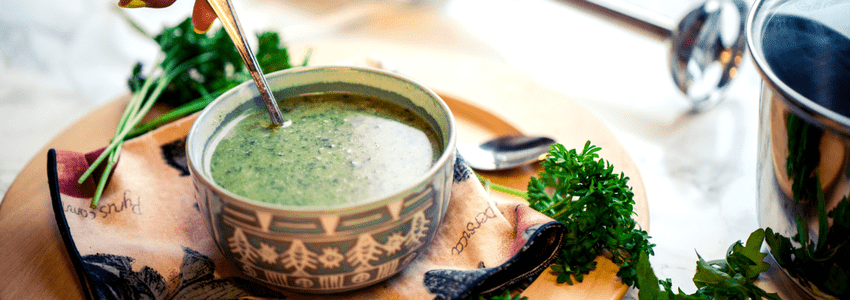
8-Ingredient Broccoli and Spinach Soup
It doesn’t have to be fall to enjoy a warm, comforting bowl of soup. So why not try this simple 8-ingredient recipe starring broccoli and spinach — two of the ingredients from your potassium-rich foods shopping list!

Bone-Healthy Spaghetti Squash Lasagna
This recipe calls for spaghetti squash, but you could easily substitute acorn squash to pack in more potassium. You’ll find acorn squash has a bolder flavor and more fibrous texture than spaghetti squash — which adds depth to this dish!
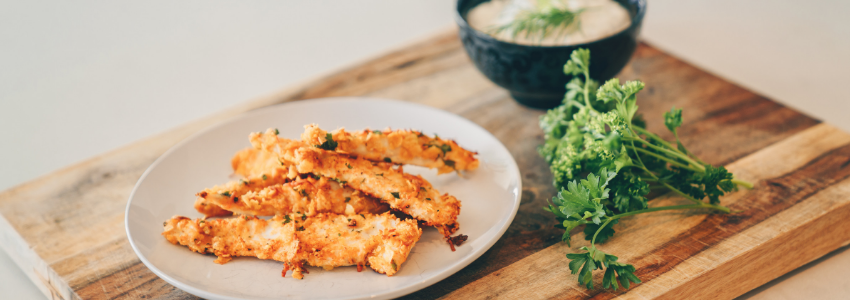
Crispy Chicken Fingers
You don’t have to feel guilty about eating chicken fingers anymore! A few clever ingredient twists transform this childhood classic into a bone-healthy meal. And as we’ve seen, chicken breast is a great source of potassium.
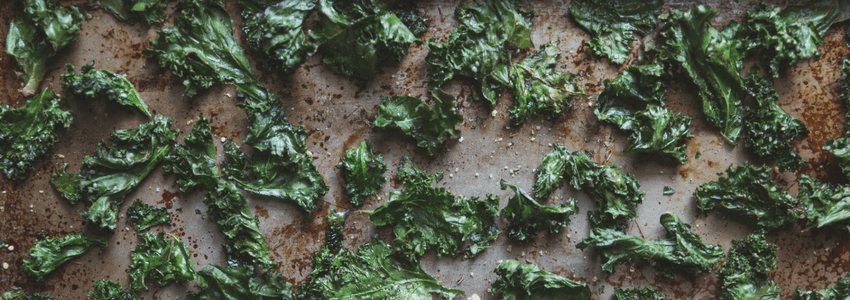
Simple and Delicious Kale Chips
Satisfy your snack cravings and up your potassium intake with these simple, healthy kale chips. This recipe is easy to make, and you don’t need many ingredients other than kale. So go ahead and give these a try for your next movie night!
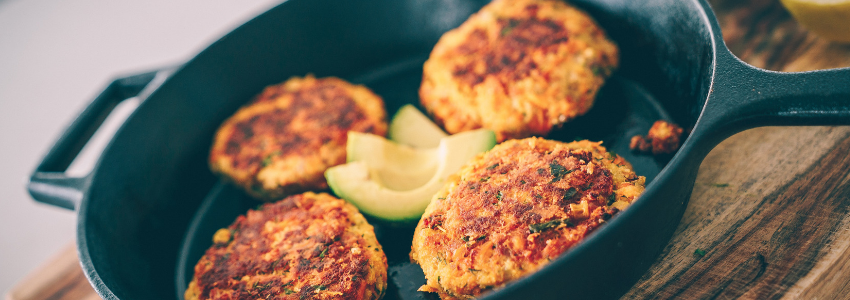
8-Ingredient Salmon Burger Recipe
Looking for ways to meet your weekly seafood quota? This delicious salmon burger recipe has you covered! Plus, these burgers take just 15 minutes to make and are packed full of bone-healthy omega 3s, protein, and potassium.
How to Get Enough Potassium for Optimal Health
By now, you’ve seen just how critical potassium is throughout your body. Your brain, heart, nerves, bones, and more all need this mineral!
You’ve also seen that the current recommendation for “adequate” daily potassium intake is 2,600 mg for women and 3,400 mg for men. But remember, this recommendation is the bare minimum you need. For optimal health, you’ll want to aim higher!
The 35 potassium-rich foods from this list are a good place to start. Incorporate them into a balanced diet, and you’ll be doing your body and your bones a favor…
A Special Note About Bone Building
Potassium is one of the 13 essential bone-supporting minerals found in AlgaeCal Plus (a natural calcium supplement that supports bone health). So AlgaeCal Plus contributes to your daily potassium intake and does something no other calcium supplement can — it increases your bone density… no matter your age!
In fact, when you take AlgaeCal Plus with Strontium Boost (the Bone Builder Pack) as directed, you’re guaranteed to increase your bone density in as little as six months. To read more about AlgaeCal Plus and Strontium Boost, click on the banner below:
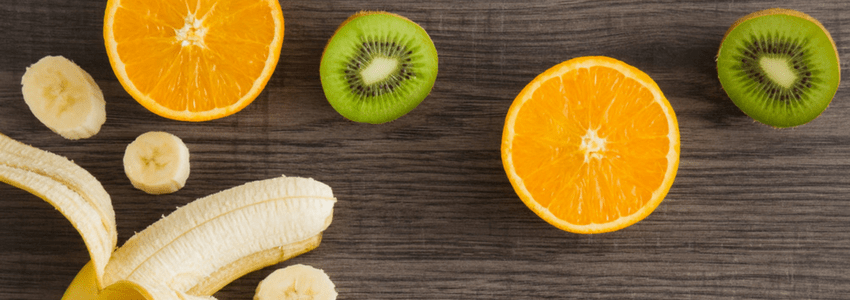




Sandra Kay Walker
June 9, 2017 , 8:37 pmI started AlgaeCal March 2017 right after mt DEX score of -2.0
Today My DEX measured -1.9 June 2017